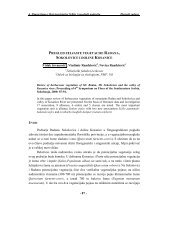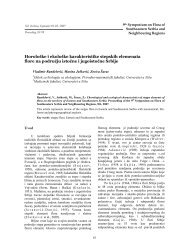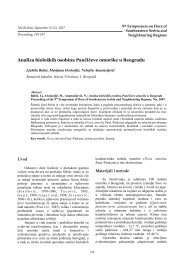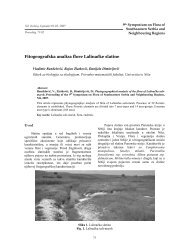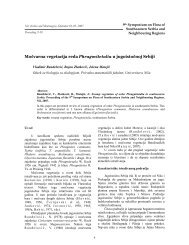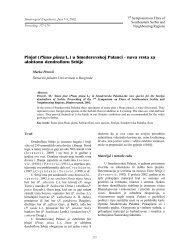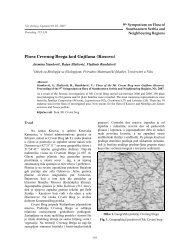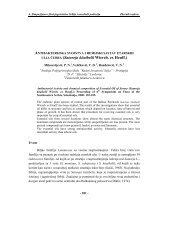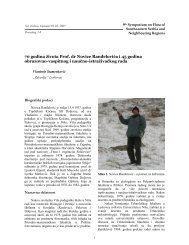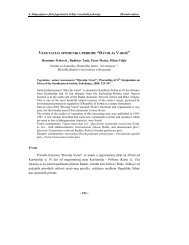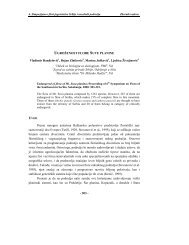10th Symposium on the Flora of Southeastern Serbia and ...
10th Symposium on the Flora of Southeastern Serbia and ...
10th Symposium on the Flora of Southeastern Serbia and ...
You also want an ePaper? Increase the reach of your titles
YUMPU automatically turns print PDFs into web optimized ePapers that Google loves.
10 th <str<strong>on</strong>g>Symposium</str<strong>on</strong>g> <strong>on</strong> <strong>the</strong> <strong>Flora</strong> <strong>of</strong> Sou<strong>the</strong>astern <strong>Serbia</strong> <strong>and</strong> Neighbouring regi<strong>on</strong>s,Vlasina 17 to 20 June 2010karst fields. The majority <strong>of</strong> species were found <strong>on</strong> open peatl<strong>and</strong>s (Sphagnumpalustre, Sph. capillifolium, Sph. denticulatum, Sph. c<strong>on</strong>tortum, Sph. subsecundum,Sph. cuspidatum, Sph. magellanicum, Sph. angustifolium, Sph. squarrosum, Sph.teres, Sph. compactum, Sph. centrale, Sph. flexuosum, Sph. papillosum <strong>and</strong> Sph.tenellum). In terms <strong>of</strong> plant sociology bog communities bel<strong>on</strong>gs to ass. Drosero –Caricetum stelullatae <strong>and</strong> Rhynchosporetum albae, both communities <strong>of</strong> transitivepeatl<strong>and</strong>s. St<strong>and</strong> s <strong>of</strong> Sphagnum medium – Polytrichum strictum <strong>and</strong> Sphagnumcapillifolium – Polytrichum l<strong>on</strong>gisetum can be recognised as fragments <strong>of</strong> raisedbogs. All peatl<strong>and</strong>s are under str<strong>on</strong>g pressure <strong>of</strong> natural successi<strong>on</strong>. Sph.quinquefarium was found <strong>on</strong> granite <strong>and</strong> silicate rocks within beech woods (ass.Blechno-Fagetum <strong>and</strong> st<strong>and</strong>s <strong>of</strong> Fagus sylvatica – Sphagnum quinquefarium). Thisspecies is also known from st<strong>and</strong>s <strong>of</strong> Pinus mugo. This st<strong>and</strong>s <strong>of</strong> mountain pine aredeveloped in deep karst dolines <strong>and</strong> could be classified as ass. Pino mugo –Sphagnetum. O<strong>the</strong>r peat moss species present here is Sph. girgensohnii. In wetwoods <strong>of</strong> spruce <strong>and</strong>/or fir (ass. Carici brizoidis – Abietetum, Blechno – Abietetum,st<strong>and</strong>s <strong>of</strong> Picea abies – Sphagnum sp. div.) Sph. platyphyllum, Sph. squarrosum,Sph. fimbriatum, Sph. angustifolium, Sph. palustre <strong>and</strong> Sph. girgensohnii developsloose or more or less dense mats. Only <strong>on</strong>e locality in wood <strong>of</strong> sessile oak <strong>and</strong>chestnut is known (ass. Querco – Castanetum sativae) with spesies Sph.angustifolium <strong>and</strong> Sph. fimbriatum distributed around small shallow lake. The mostunusual habitat <strong>of</strong> peat mosses is periodically flooded karst field where <strong>the</strong>y grow indifferent grassl<strong>and</strong> communities (e.g. ass. Nardetum strictae, Crepidi c<strong>on</strong>yzaefoliae– Molinietum altissimae) <strong>and</strong> community <strong>of</strong> blister sedge (ass. Caricetumvesicariae). Peat mosses growing in karst field are Sph. subnitens, Sph.capillidolium, Sph. teres, Sph. palustre <strong>and</strong>. Sph. denticulatum. All describedhabitats have very narrow areas <strong>of</strong> distributi<strong>on</strong>, <strong>and</strong> are under str<strong>on</strong>g pressure <strong>of</strong>successi<strong>on</strong>, change <strong>of</strong> hydrology, deforestati<strong>on</strong>, <strong>and</strong> different negative humanimpacts. Therefore active protecti<strong>on</strong> measures are <strong>of</strong> urgent necessity.26



